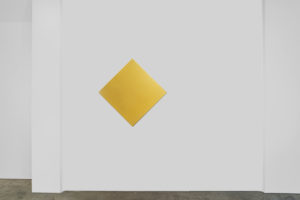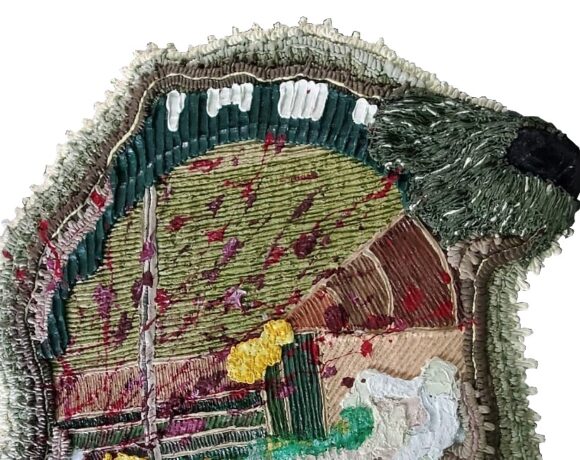Ann Veronica Janssens, born in 1956 in Folkestone (United Kingdom), spends her childhood in Kinshasa (Congo), where she manages to devote long hours to free craftsmanship and to watch the sunrise, the sunset and the movements of light in the water and in the sky. This imprinting linked to the experience of open and luminous atmospheres will prove decisive, together with the subsequent influence of the Californian minimalist artists belonging to the “Light & Space” group, in orienting her work on the investigation of light, space and perception through in situ installations closely linked to the context in which they are located and through the use of very simple or intangible materials, such as light, sound, water, glittery powder or artificial fog. Since the end of the 70s the artist, who lives and works in Brussels (Belgium), has devoted herself consistently to an experimental work in which, once the threshold of clear and controlled vision has been crossed, the observer can “meet” the perception of the elusive in fleeting devices that generate an experience of loss of control, instability and visual, physical, temporal fragility.
The main material used by Ann Veronica Janssens is light, used in liquid, solid or gaseous form: to acquire evidence and tangibility of an immaterial radiation by orchestrating with an architectural approach optical or physical phenomena such as absorption or refraction is for her a means to show the infinite manifestations of reality in a different way, to reveal how sensitive reality is much softer and more elastic than it seems at first sight, to cancel what is normally seen in an attempt to make the invisible visible. Another fundamental aspect of her work is the participation of the public: the sculptures always invite the observer to move, to walk in color, to explore different angles and experiences in a dilated temporality. The artist wants to reawaken the enormous potential of perception and destabilize every habitual approach to space by canceling out borders, angles and geometries: the gaze is lost in dilated chromatic emanations and goes back to then navigate more consciously in an infinite that passes through without interruption from the external to the internal dimension.
The minimalist consistency of her works, the result of a lucid intention to subtract, remove, decrease and reduce to reach the maximum simplicity of form through essential gestures, manages to stage the beauty of fragility in a mysteriously sumptuous way, without being distracted from the goal of investigating the limits of the visible to find new ways to overcome them. It is precisely the deep connection with the spectator’s physicality that makes her works alive, sensual creatures, never enslaved to pure optical or physiological speculation, and is at the origin of the sense of wonder that they arouse despite the extreme economy of means with which they are made.
Studio G7 gallery offers until March 20 a deep insight into the work of Ann Veronica Janssens in a highly exemplary essential setting (despite being in a commercial gallery!) of the artist’s vocation to work on immateriality through devices that alter normal perceptions to generate a “void” full of suggestions.
To welcome us at the entrance we find the installation Orange sea blue (2005), a duet of white lights with filters that project an impossible abstract landscape on the wall where the sunrise coincides with the sunset. The ephemeral monumentality of this sculpture, which could suddenly disappear just by turning off a switch, expands into space impregnating it with a slow time, the time of idleness that allows one to observe and discover the phenomena underlying the appearances of reality. The transitional forms that Ann Veronica Janssens thinks and creates through artificial lights governed by simple technical devices reflect on the immaterial essence of painting and interrogate color as an experience to be internalized through infinite gradations of afterimages. The thrill of navigating in color using the properties of light pushes the pictorial question beyond the dissolution of matter and object and projects it into a latent mental state in which the play of light concretizes the changing manifestations of the phenomena that seduce our perceptions.
The Golden square 45° turned sculpture (2013), formed by a 45° rotated square support immersed in liquid gold then solidified is placed on the opposite wall and the dialogue it establishes with Orange sea blue is so tight that it makes one think that they live in symbiosis. The gold is shiny but absorbs the brightness, therefore the work, if approached frontally to a light source, looks like a black hole: this precious dark body begins to light up and become something alive when the viewer starts to observe it from different distances and angles. Only in this way one will he be able to experience the passing of the images in the iridescent reflection of his movement on the smooth surface and the passage of time in the changing reactions of gold to changes in natural light in the different hours of the day, which generate a varied palette enriched by translucent shades emanated by Orange sea blue. Once again Ann Veronica Janssens, with this perfect square which, if observed intensely, seems to come out of its geometric limits and assume a fluid and indefinite form, neutralizes the limits that rationality imposes on perception by showing us through the deception of the senses such as things are not exactly as we know them and how the deciphering of a phenomenon does not end in itself but is the gateway to another reality.
The exhibition is ideally extended outside the gallery in an environmental intervention in the Cappella dei Carcerati in Palazzo Re Enzo, created in collaboration with Alfonso Artiaco gallery in Naples. Here the artist places three circular mirrors on the ground that overturn the perception of the fourteenth-century space already reinterpreted in a contemporary key in 2003 by Tavid Tremlett’s mural painting. Here too the expressive signature of Ann Veronica Janssens is unmistakable: the work infiltrates the public space with discretion but produces a radical change in the use of the environment and consists of a performative sculpture that reacts to the light and architectural conditions of the place that welcomes it.
Info:
Ann Veronica Janssens
25 January – 20 March 2020
curated by Chiara Bertola
Studio G7
Via Val D’Aposa 4/A Bologna



 Ann Veronica Janssens, exhibition view at Studio G7. Photo: Alessandro Fiamingo
Ann Veronica Janssens, exhibition view at Studio G7. Photo: Alessandro Fiamingo

 Ann Veronica Janssens, Santa Maria dei Carcerati, 2019. Photo: Alessandro Fiamingo
Ann Veronica Janssens, Santa Maria dei Carcerati, 2019. Photo: Alessandro Fiamingo
Graduated in art history at DAMS in Bologna, city where she continued to live and work, she specialized in Siena with Enrico Crispolti. Curious and attentive to the becoming of the contemporary, she believes in the power of art to make life more interesting and she loves to explore its latest trends through dialogue with artists, curators and gallery owners. She considers writing a form of reasoning and analysis that reconstructs the connection between the artist’s creative path and the surrounding context.






NO COMMENT